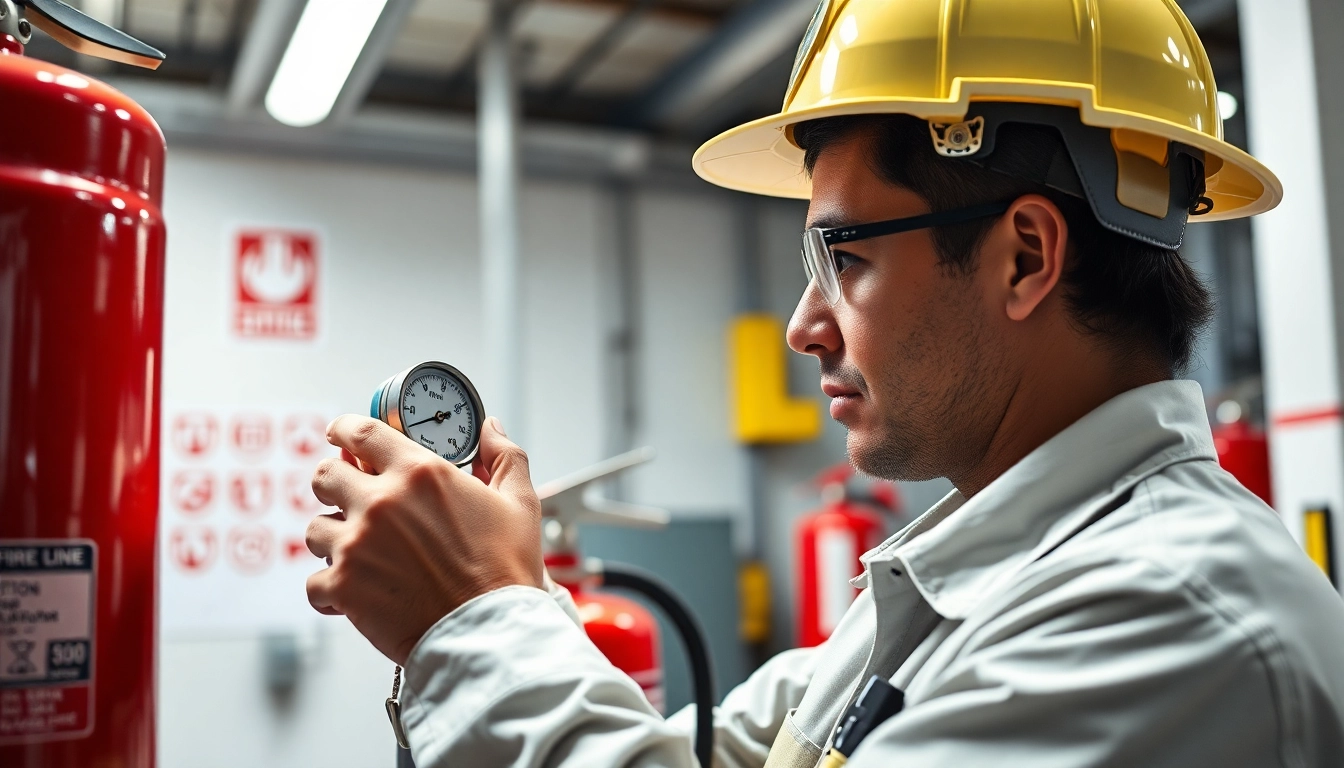Understanding Fire Extinguisher Checks
What are Fire Extinguisher Checks?
Fire extinguisher checks refer to the systematic inspections and maintenance procedures performed on fire extinguishers to ensure they are functional and ready for use in an emergency. These checks help to identify any potential issues that could impede the performance of the extinguisher, such as physical damage, low pressure, or outdated inspection tags. Proper fire extinguisher checks involve both visual assessments and more detailed maintenance protocols, which help ensure that the devices are always in optimal condition. For effective fire safety management, it is crucial to incorporate regular fire extinguisher checks into safety routines.
Importance of Regular Inspections
Regular inspections of fire extinguishers are essential for several reasons:
- Compliance with Regulations: Various local, state, and federal regulations mandate the inspection and maintenance of fire safety equipment. Ensuring compliance helps avoid fines and legal liabilities.
- Increased Safety: A well-maintained fire extinguisher can save lives and property by ensuring it operates effectively when needed. Regular checks help to minimize the risks associated with using damaged or outdated equipment.
- Cost Efficiency: Preventative maintenance can be more cost-effective than waiting for issues to arise, potentially resulting in costly damage or the need for replacements.
- Peace of Mind: Regular checks provide reassurance that fire extinguishers will function properly during emergencies, promoting a culture of safety within an organization or residence.
Legal Requirements and Standards
In the United States, legal standards governing fire extinguisher checks are primarily outlined in the National Fire Protection Association (NFPA) codes, particularly NFPA 10, which stipulates that fire extinguishers must be inspected upon installation and on a monthly basis thereafter. Additionally, annual maintenance checks are required, as well as hydrostatic testing every 5-12 years depending on the type of extinguisher. Compliance with local fire codes and insurance requirements may also dictate specific protocols and frequencies for inspections.
Steps to Perform Fire Extinguisher Checks
Monthly Visual Inspections
Conducting monthly visual inspections is a vital part of maintaining fire extinguishers. The following checklist can guide you during this evaluation:
- Accessibility: Ensure extinguishers are easily accessible and not blocked by furniture or other objects.
- Physical Condition: Check for any obvious signs of damage, such as dents, rust, or corrosion.
- Pressure Gauge: Verify that the pressure gauge is in the green zone, indicating proper pressure levels.
- Inspection Tag: Confirm that the inspection tag is up-to-date and filled out correctly to indicate the last inspection date.
Annual Maintenance Procedures
In addition to monthly checks, an annual maintenance check must be conducted by certified personnel, focusing on the following:
- Comprehensive Inspection: Examine all parts of the extinguisher, including the nozzle, handle, and cylinder for any signs of wear or damage.
- Weight Verification: Weigh the extinguisher; if it is significantly lighter than the manufacturer’s specifications, it may indicate leakage.
- Hydrostatic Testing: Perform hydrostatic testing every few years to test the integrity of the cylinder under pressure.
- Maintenance Records: Maintain meticulous records of completed inspections and maintenance to demonstrate compliance.
Documentation of Inspections
Keeping an accurate record of all inspections and maintenance performed is crucial for compliance and safety. This documentation should include:
- The date of each inspection and maintenance.
- The name of the person or company completing the inspection.
- Observations, issues identified, and corrective actions taken.
- Testing results, especially for hydrostatic tests.
Common Issues Found During Fire Extinguisher Checks
Identifying Wear and Tear
During inspections, you’ll often encounter common issues such as:
- Dents and Scratches: These can weaken the cylinder structure and compromise safety.
- Corrosion: Rust or corrosion at the mounting bracket or on the cylinder may signal that replacement is necessary.
- Worn Labels: Faded or missing labels can make it difficult for users to understand how to operate the extinguisher.
Pressure Gauge Monitoring
Monitoring the pressure gauge is crucial. If the gauge indicates a low pressure or over-pressurization, the extinguisher may be non-functional. It’s imperative to check that:
- The needle is in the green zone, suggesting the unit is ready for use.
- If any issues are observed, the equipment must be serviced immediately or replaced as needed.
Inspection Tag Verification
Every fire extinguisher should be equipped with an inspection tag showing the dates of last service and who performed it. An expired or absent tag indicates negligence and requires immediate action. Regular verification helps ensure compliance with both local regulations and organizational safety standards.
Best Practices for Fire Extinguisher Checks
Establishing a Maintenance Schedule
Creating and adhering to a comprehensive maintenance schedule is essential for effective fire extinguisher checks. This should include:
- Monthly Visual Inspections: Assign specific personnel to conduct these inspections regularly.
- Documentation Tracking: Use software or logs to track inspection dates and tasks completed.
- Annual Professional Inspections: Schedule reminders for certified professionals to conduct thorough examinations and maintenance.
Training Staff on Emergency Protocols
Training staff on how to use fire extinguishers and adhere to safety protocols greatly enhances overall safety culture. Best practices include:
- Regular Training Sessions: Conduct training sessions that include demonstrations on how to operate extinguishers correctly.
- Emergency Preparedness Drills: Integrate extinguisher use into emergency simulation drills to ensure staff familiarity.
- Visual Reminders: Place instructional signage near extinguishers to reinforce training.
Using Technology for Tracking Inspections
Leveraging technology can streamline the fire extinguisher inspection process. Consider implementing:
- Mobile Apps: Use of mobile applications to document inspections can simplify data collection and reporting.
- Automated Alerts: Set reminders for when inspections are due, ensuring compliance and reducing the chance of oversight.
- Data Analytics: Analyze inspection data for trends that may indicate issues across multiple extinguishers or locations.
Enhancing Safety with Fire Extinguisher Checks
Integrating Fire Safety Training
Fire safety training should be an integral part of your safety procedures. Activities that can contribute significantly to this integration include:
- Regular Workshops: Conduct workshops that cover fire extinguisher use, emergency evacuation plans, and general fire safety principles.
- Cross-Training Staff: Ensure that multiple employees are trained to operate extinguishers; this prepares the workplace for emergencies when specific individuals may be unavailable.
- Utilizing Simulation: Incorporate live-fire simulation training where feasible to offer practical experience.
Emergency Preparedness Plans
A comprehensive emergency preparedness plan is vital for minimizing risks during a fire. Essential components include:
- Evacuation Routes: Clearly marked and accessible routes for evacuation should always be visible.
- Designated Meeting Areas: Establish meeting points where personnel can regroup and be accounted for after an evacuation.
- Communication Systems: Use of alarms, announcements, and training on communication processes can significantly improve response times.
Evaluating Effectiveness of Fire Safety Measures
Continuous evaluation of fire safety measures, including extinguisher efficacy, is critical. Regular assessment can include:
- Post-Incident Evaluations: After any fire incident, a review of how fire equipment performed can provide valuable insights for improvements.
- Routine Feedback Mechanisms: Encourage staff feedback on fire safety practices and equipment to identify areas for improvement.
- Updating Protocols: Regularly update your emergency response protocols based on evaluations to incorporate new safety procedures and technology advancements.



